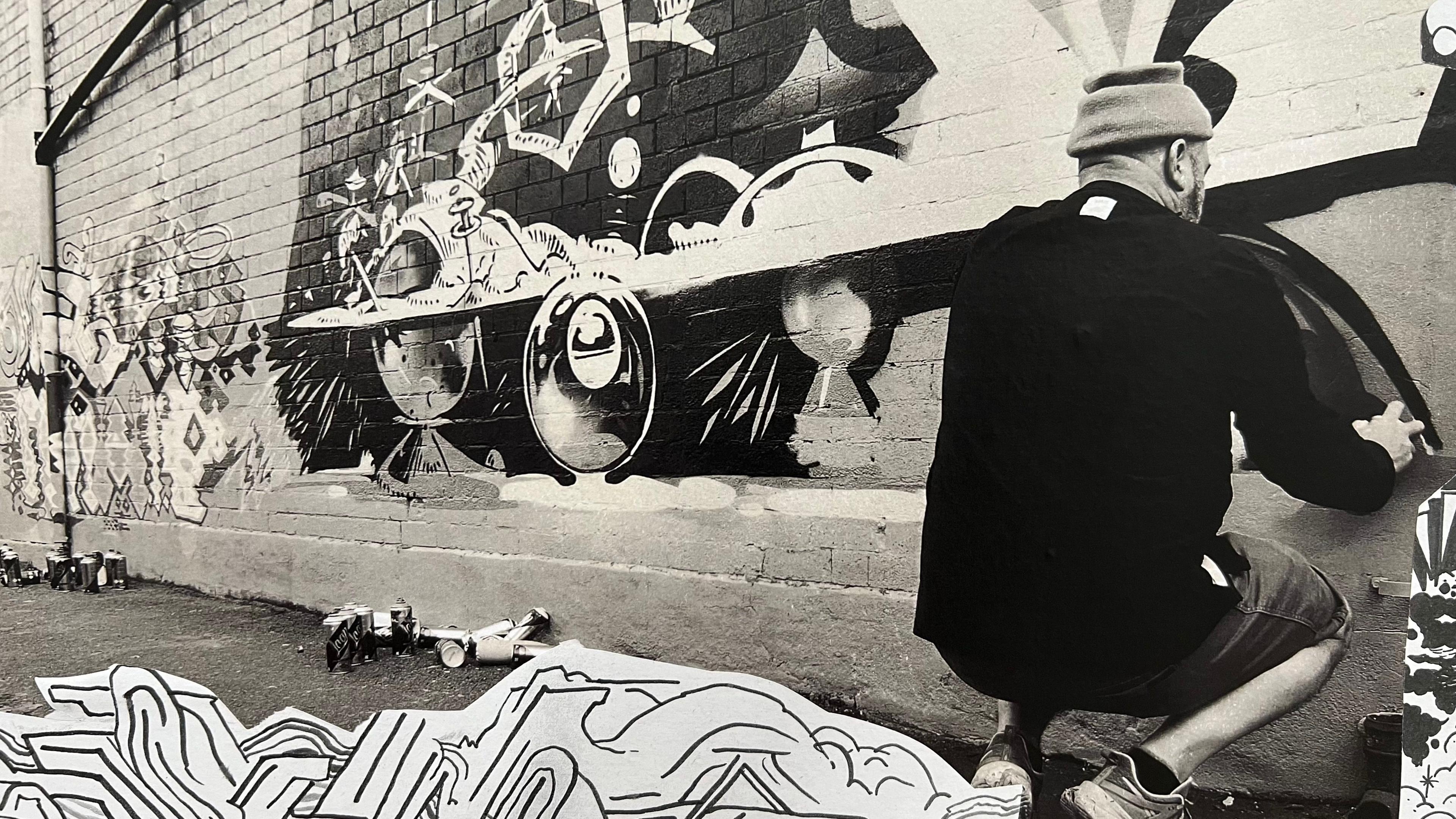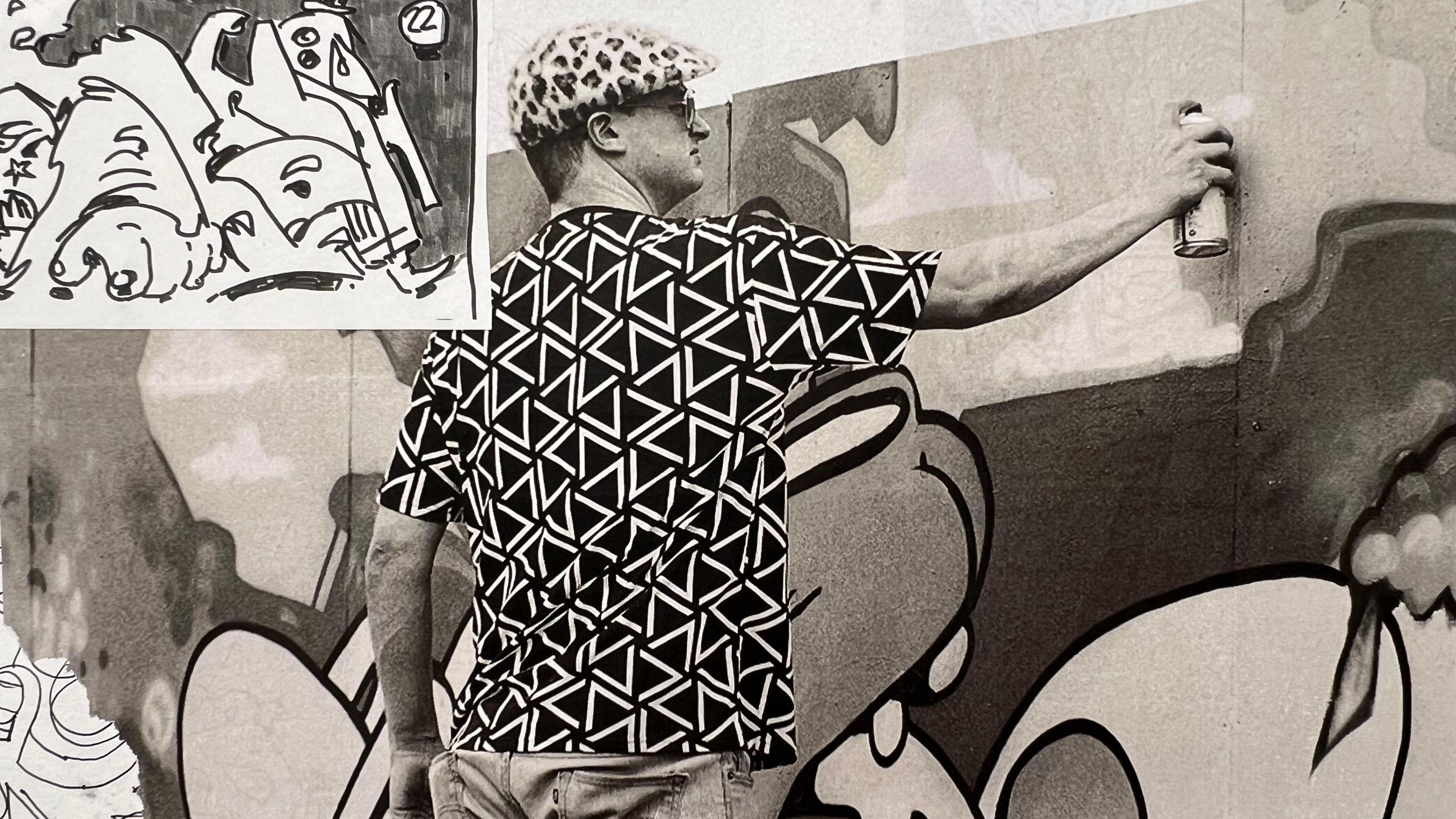Paul Heaton's photos of Hull's graffiti on show
- Image source, Paul Heaton

Image caption, Photos of Hull's graffiti scene, some taken by singer Paul Heaton in the 1980s, are on show at Humber Street Gallery
1 of 6
- Published
Previously unreleased photos of Hull's burgeoning street artists taken by singer Paul Heaton during the 1980s are among the artwork on show celebrating four decades of the city's graffiti art scene.
The exhibition at Humber Street Gallery features the work of 20 artists including Pinky and Graham Dews, known by his tag name Paris, who has designed for Coldplay, Glastonbury Festival and the London Olympics.
It also includes 15 images taken by former Housemartins and Beautiful South singer Heaton, when he lived near Grafton Street, close to one of the graffiti locations.
Pinky said seeing Heaton's photographs of him and his peers taken 40 years ago for the first time was "just incredible".
"In the early 80s we had a couple of places that we used to hang out - there was a whole group of us teenagers.
"One of the main places we used to hang out was a little park on Alexandra Road, which is known as TAG Park and we used to paint on there. Paul Heaton had a house [nearby] on Grafton Street so we used to know him a little bit."
Pinky, who lives in Brighton and has worked for The Guardian and Glastonbury Festival as an illustrator, said it was "amazing" to receive Heaton's photographs after contacting him six months ago when he found out about the singer's archive from a friend.

Pinky (second left) is among 20 artists involved in the exhibition
Abandoned buildings on industrial sites including Stoneferry and Chapman Street areas, Ings shopping centre, housing estates, cycle paths, as well as various parks across the city are some of the locations captured in the exhibition called Live Like Legends.
Paris, who later moved to Bristol and has worked with Banksy, said the show, which includes past and new creations, revealed the conditions in which graffiti and street art was allowed to "flourish and bloom" in the post-World War Two and industrial city.
"There were so many abandoned buildings and derelict sites, we had so many wasteland playgrounds where we could do our art out of harm's way. So there was never any confrontation with the law.
"I think what our art form did is flower in places where industry had died. So you had one industrial movement ending and a new creative art form took a foothold and grew.
"[At the time] it was something new and exciting, we all jumped on it. Incredibly, I wouldn't believe that I'm now doing it in my late forties but I've made a life doing this. It's helped a lot of us."

Artist Lonny Pop said she was mind blown by the creativity adorning the city's abandoned warehouses
Brighton-based artist Lonny Pop, whose paintings also feature in the exhibition, moved to Hull to study drama in 1989 and said she was in awe after meeting Pinky, who showed her painted abandoned warehouses on the outskirts of the city.
"My mind was just completely blown. I'd never really encountered visual art like that.
"It was like an unofficial colourful amazing gallery. Every single wall in the room of these old industrial warehouses was covered in these huge wall paintings and my mind was just blown. I was like 'I really want to be part of this'.
"I started writing poems and putting those on walls and then later started painting myself. But yes, I'm really inspired by these guys."

Paris has worked on large scale projects for Coldplay, Glastonbury Festival and Banksy
While the global cultural phenomenon of spraying walls and subways took hold in major cities and was often "misunderstood", Paris said the "geographical remoteness" of Hull meant artists were not easily influenced by styles and scenes from elsewhere.
"Within Hull something unique has been brewing creatively. And we don't like to shout about it too much either. So what we're doing here with this show is really scooping all of it together and celebrating it."
While enjoying mainstream success working on projects with Banksy, including one in Bethlehem, as well as designing stage sets for Coldplay, Paris said he most enjoyed getting together with "my old friends painting in a location".
"The Banksy stuff - that whole world will make your head spin, especially if you're from Hull.
"It's kind of mind blowing and it's almost a bit too wild to believe," he said.
Follow BBC East Yorkshire on Facebook, external, X (formerly Twitter), external and Instagram, external. Send your story ideas to eastyorkslincs.news@bbc.co.uk, external




